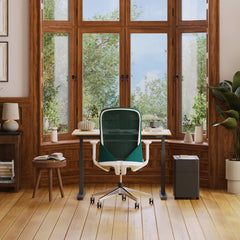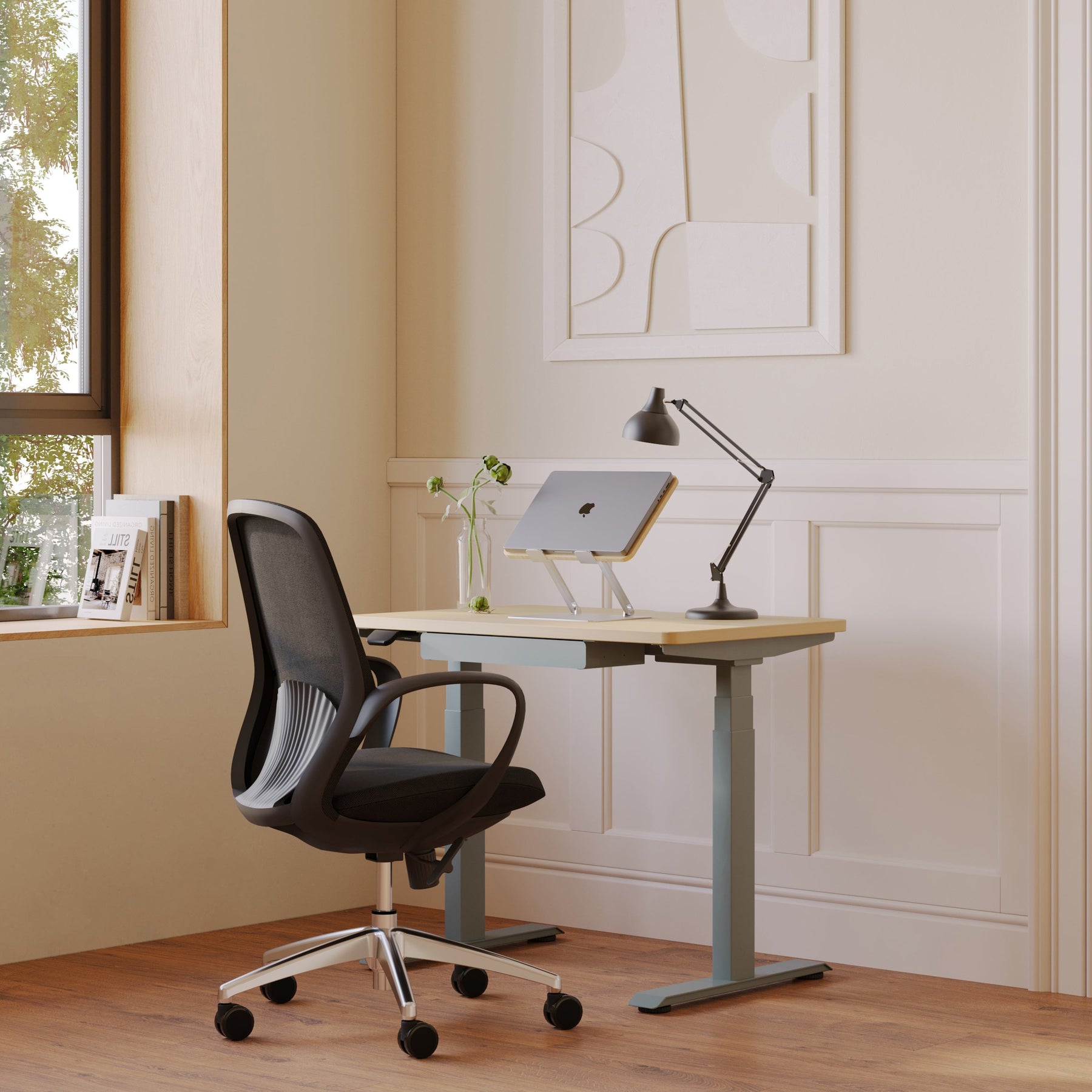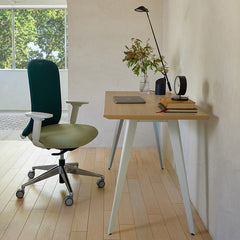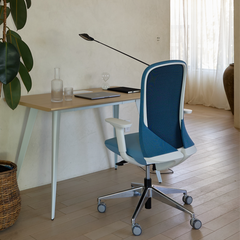Get 10% off your first order
Find the office furniture that’s designed to match your style, comfort, and needs perfectly. Subscribe
How to Arrange Furniture to Maximize Peace

Visit quiz page to see how we makes it easy to create an inspiring workplace


The traditional separation between "home" and "office" has largely vanished. For many, a single room must now serve as a functional workspace, a comfortable living area, and a sanctuary for rest. Designing this multi-functional space is one of the biggest challenges in modern home aesthetics and efficiency. The goal is to create zones that feel entirely distinct, allowing you to seamlessly switch from "Work Mode" to "Living Mode" without the psychological clutter of a blended environment.
Success in multi-functional design relies on intentionality, not size. Even the smallest apartment can be optimized through smart spatial planning, adaptable furniture, and rigorous boundary-setting. When designed correctly, your space works for you, supporting your focus during the day and your relaxation at night.
A multi-functional space works because of clear zoning—the psychological and physical separation of activities. Your brain relies on environmental cues to dictate behavior. A well-designed zone tells your mind precisely what activity is permitted there. This prevents the constant mental friction caused by feeling like you are always at work, or always distracted at home.
The right furniture is the key tool for creating these adaptable zones. A height-adjustable standing desk can transform from a standard desk to a console table when lowered, providing the crucial functional shift needed to define boundaries between working and living.
The first step in designing a multi-functional space is clearly identifying the two primary functions: the Work Zone (for high-focus, high-tech activity) and the Rest/Living Zone (for relaxation, dining, and socializing). Every design decision must support the clear separation of these two areas.
Map out your space, determining the quietest, best-lit corner for the Work Zone and the most central, comfortable area for the Living Zone. Ensure the pathways (flow) between the two are clear and unobstructed.
Work Zone: Should be placed against a wall or in a corner to minimize visual distractions and traffic.
Living Zone: Should command the center or the area with the best natural light, inviting relaxation.
Since walls are not an option, you must use furniture and accessories to create visual barriers that signal the shift from one zone to the next. These barriers define the space without closing it off entirely.
Items should be placed perpendicularly to the wall to create a soft divide. The back of a sofa, a tall, open bookshelf, or a simple folding screen are excellent tools for this purpose.
For instance, placing a sturdy, professional work surface like a modern office desk with its back toward the living area is highly effective. It creates a physical and psychological barrier, keeping work out of the relaxation zone’s sightline.
Visual Barrier Checklist:
☐ Vertical Shelving: Use open shelving that can display decorative items while physically separating the zones.
☐ Area Rugs: Use different rugs in the work and living zones to define distinct boundaries visually.
☐ Low Console Tables: Place a low table behind a sofa to act as a separation point.
Every piece of furniture in a multi-functional space must justify its existence, ideally by serving two distinct functions. This eliminates clutter and maximizes available floor space.
Look for items that can easily transform or disappear when not in use. This preserves the aesthetic of the living space when the workday is over.
Dual-Function Furniture Ideas (Table):
|
Furniture Type |
Work Mode Function |
Living Mode Function |
|
Console Desk |
Laptop workstation |
Entry table/storage |
|
Ottoman |
Temporary side table/storage |
Footrest/extra seating |
|
Sofa Bed |
Primary seating |
Guest sleeping area |
|
Shelving |
Document storage |
Decorative display |

In a truly multi-functional room, the dedicated Work Zone must be space-efficient. Large, fixed workstations create visual and physical friction, overwhelming the living space.
The work area should be minimal, only containing essential tools. This is where small-footprint, yet highly functional, furniture excels. For rooms where space is a critical constraint, a focused solution is necessary. A compact and adjustable unit, such as a Small Standing Desk Vermont, provides the full benefits of dynamic working while ensuring the Work Zone remains tight, controlled, and visually contained within its allotted area.
Use wall space (floating shelves, pegboards) to move storage vertically, keeping the floor and desk surface clear and visually open.
Nothing screams "clutter" and "work-in-progress" louder than tangled cables and exposed technology. In a shared space, all work hardware must be manageable and, ideally, concealable.
When the workday ends, the technology must physically and visually disappear. This is a non-negotiable step in transitioning the space back to its "Living Mode."
Technology Concealment Strategies (Enumeration):
Cable Trays and Sleeves: Install cable management trays and sleeves beneath the desk to hide wires entirely from view.
Monitor Management: Use an adjustable mount to effortlessly push the monitor flat against the wall or out of sight when not in use.
Laptop and Peripherals Storage: Use decorative boxes or baskets to store the mouse, external keyboard, and laptop when shut down.
Wi-Fi Router/Modem: Place networking equipment inside a decorative box with ventilation holes to conceal blinking lights and wires.
Lighting is one of the most powerful and flexible tools for defining zones and cues. Different light sources can instantly signal the shift between high-alert focus and relaxed rest.
The Work Zone needs bright, focused task lighting (white/daylight spectrum) to maintain alertness, while the Living Zone needs soft, warm ambient light (yellow spectrum) to promote relaxation.
Lighting Separation (Bullet Points):
Task Lamp Focus: Use a directional desk lamp over the work area and turn it off when transitioning.
Ambient Warmth: Rely on soft floor lamps and decorative table lamps in the living area; turn these on when transitioning.
Smart Bulbs: Use smart lighting to quickly change color temperature and brightness with a voice command, automating the mode switch.
Designing a multi-functional space is fundamentally about behavioral science. The physical cues you establish must be reinforced by strict habits to maintain the boundaries and prevent the two modes from blurring. The scientific literature confirms that this multidisciplinary approach is essential for reducing the risk of musculoskeletal issues, with detailed research into the biomechanics of ergonomic furniture design demonstrating the tangible impact of well-engineered desks and chairs on posture enhancement, muscle engagement, and overall user well-being.
Research on human factors and design confirms that the physical environment profoundly influences behavior and well-being. A structured environment aids in reducing cognitive effort. Maintaining clear zone separation allows the mind to enter a high-focus state more easily. This concept is explored in detail in studies on human factors in design, which examine how the environment dictates productivity.
Accessories in a multi-functional space must be curated with extreme care. Every item must actively contribute to the desired mood or function of its zone; otherwise, it is simply clutter that undermines the design's effectiveness.
Work Zone Accessories: Desk accessories should be organized, high-function tools (e.g., a pen holder, a simple notebook, an ergonomic tool).
Living Zone Accessories: Accessories should be comforting and aesthetic (e.g., throw pillows, plants, decorative art).
Even functional ergonomic items need to be aesthetically integrated. A precision tool like an adjustable monitor arm should have a clean, neutral finish that minimizes its visual impact when not actively being used, allowing it to blend into the home environment.
While maintaining an overall cohesive aesthetic, use subtle shifts in color, texture, and materials to define your two zones further. This adds depth without visual chaos.
Work Zone: Use slightly cooler tones (grays, blues) and materials with cleaner, smoother lines (metal, glass) to promote alertness.
Living Zone: Use warmer tones (creams, terracottas) and softer, textured materials (wood, linen, velvet) to promote relaxation.
Color and Texture Strategy (Checklist):
☐ Paint Accent: Use a different, but complementary, paint shade on the Work Zone wall.
☐ Wall Art: Choose visually stimulating or high-focus art for the Work Zone and calming, abstract art for the Living Zone.
☐ Textile Shift: Use structured pillows in the Work Zone chair and plush, soft pillows on the sofa.
The most critical step in multi-functional design is the transition ritual. This physical act of "closing down" the office is what seals the boundary and allows you to mentally enter "Living Mode."
The ritual must be a simple, non-negotiable sequence of actions that visually and physically restores the space to its relaxed state.
End-of-Day Ritual
Power Down: Shut down the computer and store the laptop and external keyboard.
Restore: Push the chair in, put away any notes, and wipe down the desk surface.
Light Shift: Turn off all task lighting and turn on the ambient, warm living area lights.
Acoustic Change: Switch off work-related music/noise-canceling and turn on relaxing background music or simply embrace silence.

Designing a multi-functional space is a rewarding exercise in discipline and creativity. By treating furniture placement as architecture and ritual as a necessity, you stop fighting the limitations of your home and start maximizing its potential. The seamless shift between "work" and "life" is no accident; it is a design achievement built on clear boundaries, smart furniture, and the commitment to giving every activity its own dedicated space and mental cue. Enjoy the focused productivity of your office and the instant comfort of your home, all within the same four walls.

How to Arrange Furniture to Maximize Peace

Crafting Calm: Your Guide to the Perfect Reading Corner

Designing a Low-Waste Home Interior with High-Quality Furniture
Get 10% off your first order
Find the office furniture that’s designed to match your style, comfort, and needs perfectly. Subscribe
Leave a comment